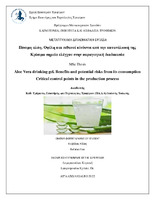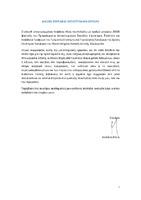| dc.contributor.advisor | Λαμπροπούλου, Κυριακή | |
| dc.contributor.author | Κεφάλας, Ηλίας | |
| dc.date.accessioned | 2022-04-14T12:17:58Z | |
| dc.date.available | 2022-04-14T12:17:58Z | |
| dc.date.issued | 2022-03-30 | |
| dc.identifier.uri | https://polynoe.lib.uniwa.gr/xmlui/handle/11400/2132 | |
| dc.identifier.uri | http://dx.doi.org/10.26265/polynoe-1983 | |
| dc.description.abstract | Η Aloe Vera, ένα χυμώδες πολυετές και ανθεκτικό στην ξηρασία φυτό, είναι πολύ γνωστό από την αρχαιότητα για τις θεραπευτικές του ιδιότητες. Λόγω αυτών των ιδιοτήτων παράγονται και κυκλοφορούν στην αγορά αρκετά σκευάσματα πόσιμης αλόης τα οποία υπόσχονται πληθώρα ευεργετικών ιδιοτήτων προς τους καταναλωτές. Στην παρούσα εργασία, μελετώνται οι ευεργετικές ιδιότητες της πόσιμης αλόης, οι πιθανές παρενέργειες που δύναται να παρουσιάσει η υπερβολική κατανάλωσή της καθώς επίσης και οι πληθυσμιακές ομάδες στις οποίες δεν ενδείκνυται η κατανάλωσή της. Επίσης περιγράφεται η παραγωγική διαδικασία της πόσιμης αλόης και προσδιορίζονται τα κρίσιμα σημεία ελέγχου. Μέσω βιβλιογραφικής ανασκόπησης, παρουσιάζονται οι αντιοξειδωτικές, αντιφλεγμονώδεις, αντικαρκινικές, αντιμικροβικές, αντιιϊκές, υπατοπροστατευτικές, ανοσοβιολογικές, γαστρεντεροπροστατευτικές, επουλωτικές, αντιδιαβητικές και καρδιοπροστατευτικές ιδιότητες της πόσιμης αλόης. Επίσης περιγράφονται οι επιδράσεις της πόσιμης αλόης στο αναπνευστικό και στο νευρικό σύστημα καθώς και οι επιδράσεις της στην στοματική κοιλότητα.
Σχετικά με τις παρενέργειες της υπερβολικής κατανάλωσης πόσιμης αλόης φαίνεται να συνδέονται με πιθανή κυτταροτοξικότητα, νεφροτοξικότητα, ηπατοτοξικότητα και ορισμένοι δερματικοί ερεθισμοί. Άτομα τα οποία δεν ενδείκνυται να καταναλώνουν
πόσιμη αλόη είναι τα παιδιά ηλικίας κάτω των 10 ετών, άτομα τα οποία πάσχουν από ορισμένες ασθένειες (εντερική απόφραξη, οξείες φλεγμονώδεις εντερικές παθήσεις π.χ. νόσο του Crohn, σκωληκοειδίτιδα και μη διαγνωσμένο κοιλιακό άλγος), οι έγκυες και οι θυλάζουσες γυναίκες και άτομα τα οποία λαμβάνουν ορισμένα φάρμακα. Η παραγωγική διαδικασία ξεκινάει με την παραλαβή των φύλλων της αλόης και πλύσιμο αυτών. Μετά από το πλύσιμο τα φύλλα τεμαχίζονται και αποφλοιώνονται, προκειμένου να ληφθεί η γέλη. Ακολουθεί ομογενοποίηση και ήπια θερμική επεξεργασία για την αδρανοποίηση των ενζύμων. Στη συνέχεια η γέλη αναμιγνύεται με ορισμένα πρόσθετα, παστεριώνεται και ψύχεται. Τέλος, η πόσιμη αλόη εμφιαλώνεται, αποθηκεύεται και διανέμεται σε θερμοκρασία περιβάλλοντος. Τα κρίσιμα σημεία ελέγχου αυτής της παραγωγικής διαδικασίας αποτελούν η παστερίωση και η ψύξη της πόσιμης αλόης. Το συμπέρασμα της μελέτης είναι ότι η πόσιμη αλόη αποτελεί ένα δυνητικά εξαιρετικό εναλλακτικό φυτικό φάρμακο για την θεραπεία ορισμένων νόσων ή έστω για την ανακούφιση των συμπτωμάτων τους. Ωστόσο οι λανθασμένοι χειρισμοί της πρώτης ύλης κατά την διάρκεια της παραγωγικής διαδικασίας και η υπερβολική κατανάλωση είναι πιθανόν να επιφέρουν αρνητικά αποτελέσματα. | el |
| dc.format.extent | 119 | el |
| dc.language.iso | el | el |
| dc.publisher | Πανεπιστήμιο Δυτικής Αττικής | el |
| dc.rights | Αναφορά Δημιουργού - Μη Εμπορική Χρήση - Παρόμοια Διανομή 4.0 Διεθνές | * |
| dc.rights | Attribution-NonCommercial-NoDerivatives 4.0 Διεθνές | * |
| dc.rights.uri | http://creativecommons.org/licenses/by-nc-nd/4.0/ | * |
| dc.subject | Πόσιμη Aloe Vera | el |
| dc.title | Πόσιμη αλόη. Οφέλη και πιθανοί κίνδυνοι από την κατανάλωσή της. Κρίσιμα σημεία ελέγχου στην παραγωγική διαδικασία | el |
| dc.title.alternative | Aloe Vera drinking gel. Benefits and potential risks from its consumption. Critical control points in the production process | el |
| dc.type | Μεταπτυχιακή διπλωματική εργασία | el |
| dc.contributor.committee | Tsaknis, John | |
| dc.contributor.committee | Τσάκαλη, Ευσταθία | |
| dc.contributor.faculty | Σχολή Επιστημών Τροφίμων | el |
| dc.contributor.department | Τμήμα Επιστήμης και Τεχνολογίας Τροφίμων | el |
| dc.contributor.master | Καινοτομία, Ποιότητα και Ασφάλεια Τροφίμων | el |
| dc.description.abstracttranslated | Aloe Vera, a succulent perennial and drought-resistant plant, has been known since antiquity for its healing properties. Due to these properties, several aloe vera preparations are being produced and marketed promising a multitude of beneficial properties to consumers. In the present study, the beneficial properties of Αloe Vera drinking gel, the possible side effects that may occur due to its excessive consumption as well as the population groups in which its consumption is not indicated, are studied. The production process of oral aloe is also described, and the critical control points are identified. Through literature review, the antioxidant, anti-inflammatory, anti-cancer, antimicrobial, antiviral, hypoprotective, immuno-biological, gastrointestinal, healing, anti-diabetic and cardioprotective properties of Αloe Vera drinking gel are being summarized. The effects of Αloe Vera drinking gel on the respiratory and nervous systems as well as its effects on the oral cavity are also described. Possible cytotoxicity, nephrotoxicity, hepatotoxicity and some skin irritations regarding the side effects of excessive consumption of oral aloe are also presented. People who should not consume Αloe Vera drinking gel are children under the age of 12, people suffering from certain diseases (intestinal obstruction, acute inflammatory bowel disease eg Crohn's disease, appendicitis and undiagnosed abdominal pain), pregnant and lactating women, and people under certain medications. The production process begins with the receipt of aloe leaves with the receipt and washing of aloe leaves. The leaves are chopped and peeled to obtain the gel. This is followed by homogenization and gentle heat treatment to inactivate the enzymes. The gel is then mixed with some additives, pasteurized and cooled. Finally, Αloe Vera drinking gel can be bottled, stored and distributed at room temperature. The critical control points of
this production process are the steps of pasteurization and cooling of Αloe Vera drinking gel. As a conclusion of this study, Αloe Vera drinking gel is a potentially excellent alternative herbal remedy for the treatment of certain diseases or even for the relief of their symptoms. However, incorrect handling of the raw material during the production process and excessive consumption are likely to have negative effects. | el |



